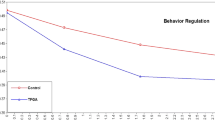Abstract
This study investigates the effectiveness of a weekly cognitive behavioral counseling group with 153 first- through fifth-grade students referred with academic behaviors, academic motivation, and classroom behavioral problems. Students met weekly for six weeks with a school psychologist or intern in heterogenous groups of five similarly-aged students. Each week the classroom teacher provided an evaluative grade for all areas that were specified in an individualized student behavior plan. Significant improvement was found comparing baseline and week-6 grades. During the sixth week the most frequently occurring behavioral score was 3.00 (B grade). Improvement was not dependent on student grade level or type of problem identified by the teacher prior to the intervention. This study extends previous research by using a cognitive behavioral group intervention with early elementary students who had a broad range of classroom problems. Details regarding the progression of activities occurring in the groups are also provided.
Similar content being viewed by others
References
Batsche, G. M., & Knoff, H. M. (1995). Best practices in linking assessment to intervention. In A. Thomas & J. Grimes (Eds.), Best practices in school psychology III (pp. 569–585). Washington, DC: National Association of School Psychologists.
Boutwell, D., & Myrick, R. D. (1992). The go for it club. Elementary School Guidance and Counseling, 27, 65–72.
Browning Wright, D., & Gurman, H. B. California Association of School Psychologists, Diagnostic Center, Southern California Positive Intervention Task Force. (1998). Positive intervention for serious behavior problems: Best practices for implementing the positive behavioral intervention regulations. Sacramento, CA: California Department of Education.
Cairns, R. B., Cairns, B. D., & Neckerman, H. J. (1989). Early school dropout: Configurations and determinants. Child Development, 60, 1437–1452.
Clark, L., & Elliott, S. N. (1988). The influence of treatment strength information on knowledgeable teachers’ pretreatment evaluations of social skills training methods. Professional School Psychology, 3, 241–251.
Conoley, J. C., & Conoley, C. W. (1991). Collaboration for child adjustment: Issues for school- and clinic-based psychologists. Journal of Consulting and Clinical Psychology, 59, 821–829.
Gresham, F. M. (1989). Assessment of treatment integrity in school consultation and prereferral intervention. School Psychology Review, 18, 37–50.
Hallahan, D. P., Hall, R. J., Ianna, S. O., Kneedler, R. D., Lloyd, J. W., Loper, A. B., & Reeve, R. E. (1983). Summary of research findings at the University of Virginia Learning Disabilities Research Institute. Exceptional Education Quarterly, 4, 95–114.
Hallahan, D. P., Lloyd, J., Klosiewicz, M. M., Kauffman, J. M., & Graves, A. W. (1979). Self-monitoring of attention as a treatment for a learning disabled boy’s off-task behavior. Learning Disability Quarterly, 2, 24–32.
Harvey, V. S. (1995). Best practices in teaching study skills. In A. Thomas & J. Grimes (Eds.), Best practices in school psychology III (pp. 931–942). Washington, DC: National Association of School Psychologists.
Lewis, B. L., & Strain, P. S. (1978). Effects of feedback timing and motivational content on teachers’ delivery of contingent social praise. Psychology in the Schools, 15, 423–430.
Myrick, R. D. (1993). Developmental guidance and counseling: A practical approach. Minneapolis, MN: Educational Media Corporation.
Sagatsky, G., Patterson, C. J., & Lepper, M. R. (1978). Training children’s self-control: A field experiment in self-monitoring and goal setting in the classroom. Journal of Experimental Child Psychology, 25, 242–253.
Spivak, G., & Marcus, J. (1987). Marks and classroom adjustment as early indicators of mental health at age twenty. American Journal of Community Psychology, 15, 35–55.
Strublem, J. B. (1971). The application of positive social reinforcement to the behaviors of getting ready to work. School Applications of Learning Theory, 1, 34–39.
Tharinger, D., & Stafford, M. (1995). Best practices in individual counseling of elementary-age students. In A. Thomas & J. Grimes (Eds.), Best practices in school psychology III (pp. 893–907). Washington, DC: National Association of School Psychologists.
Tuma, J. M. (1989). Mental health services for children: The state of the art. American Psychologist, 44, 188–199.
Author information
Authors and Affiliations
Corresponding author
Additional information
The author would like to express appreciation to Dr. Brent Duncan, Dr. Shane Jimerson, and Dr. Michael Furlong for their assistance and support in revising this manuscript.
Rights and permissions
About this article
Cite this article
Richardson, A.T. Effectiveness of a Cognitive Behavioral Group Intervention for Elementary Aged Students. Contemp School Psychol 6, 39–45 (2001). https://doi.org/10.1007/BF03340882
Published:
Issue Date:
DOI: https://doi.org/10.1007/BF03340882




